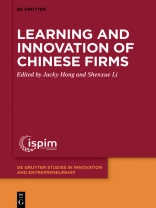This edited volume explores the learning and innovation of Chinese firms. In particular, it examines the difficulties and obstacles affecting the technological collaboration between Chinese firms and foreign partners as well as some of the key organizational and institutional challenges of innovation facing Chinese firms.
Despite enjoying rapid economic growth in previous decades, learning and innovation of Chinese firms has received relatively limited attention among management and international business scholars in the past. However, some significant changes in the Chinese institutional environment have occurred in recent years. On one hand, the Chinese central government has devised a number of policy initiatives to promote and support innovative activities in China, ranging from the ‘Mass Entrepreneurship and Innovation by All’ to the latest ‘Made in China 2025’. On the other hand, we have witnessed an increasing number of indigenous Chinese firms (e.g. Alibaba, Baidu, Tencent, Huawei and DJI) adopting business model innovation with global inputs and impacts in different business sectors, namely electronic commerce, telecommunication network equipment, social media, mobile payment and drones.
In view of these recent developments, we aim to further our understanding about the learning and innovation processes of Chinese firms in this edited volume.
विषयसूची
Part I: Introduction and Background
Chapter 1
Introduction
The chapter presents a current overview of the innovation of Chinese firms and outlines the contributions in this edited volume.Jacky Hong and Shenxue Li
Part II: Technology transfer and innovation
This part explores the link between foreign technology transfer and indigenous innovation in China. For example, how do Chinese firms collaborate with foreign partners to promote technology transfer and innovation? What are the difficulties and obstacles affecting the technological collaboration between Chinese firms and foreign partners?Chapter 2
Foreign direct investments and innovation in China
This chapter explores the impact of foreign direct investment on technological innovation in China- Current status of foreign direct investment in China
- Technological innovation in Chinese firms
- The roles of foreign direct investment on fostering technological innovation
Pervez Ghauri
Chapter 3
Knowledge transfer in international joint ventures
This chapter investigates how international joint venture can serve as a major channel for promoting knowledge transfer to China- Types of knowledge
- Barrier of knowledge transfer in international joint venture
- Case studies
Eric W.K. Tsang
Part III: Entrepreneurship, learning and innovation
This part identifies the characteristics of technological entrepreneurs in China. For example, what are the social, financial, cultural and political challenges facing technological entrepreneurs in China? How do Chinese entrepreneurs contribute to innovative ventures in China?Chapter 4
Sensemaking processes in Chinese entrepreneurial firms
This chapter explores the sensemaking process that unfolds in entrepreneurial firms by investigating how entrepreneurial firms navigate through uncertainty and equivocality- Entrepreneurial learning as sensemaking
- Sensemaking processes in entrepreneurial firms
- Case studies
Xi Zhou, Jacky Hong and Robin Snell
Chapter 5
Guanxi networks and Chinese entrepreneurship
This chapter reviews the development ofguanxi network in China and the impact on entrepreneurship
- The concept of guanxi
- Proliferation of guanxi networks in China
- Use of guanxi for Chinese startups
Chris Rowley
Chapter 6
Developing learning organization in China
This chapter assess the potential and obstacles for Chinese firms to become the learning organizations- Spiritual foundations of learning organization
- Chinese Confucian values
- Case studies
Carry Mak and Anders Örtenblad
Part IV: Institutions and innovation
This part explores the roles played by the regional and national government in China for promoting innovation and learning of Chinese firms. For example, how do various institutional actors such as VCs, universities, research institutes interact with each other in shaping the process of innovation in China? How do innovation ecosystems (e.g. regional clusters, science parks and R&D networks) take shape in China?Chapter 7
Innovation ecosystems in China
This chapter explores how the key actors in innovation ecosystem interact with each other in shaping the process of innovation in China- An ecosystem perspective of innovation
- A Chinese ecosystem of innovation
- Innovative behaviors of Chinese firms
Jiangyong Lu
Chapter 8
Public-private partnerships and innovation in China
This chapter draws on a conceptual framework of public-private partnerships to investigate how partner organizations can develop effective innovation in China- Motives of cooperation
- Innovation within public-private partnerships
- Case studies
Nelson Santos António
Part V: Conclusion
Chapter 9
Concluding remarks
The chapter summarizes the key organizational and institutional challenges of innovation facing Chinese firms. Some areas for future research will also be proposed.Jacky Hong and Shenxue Li
लेखक के बारे में
Jacky Hong is a Professor of Management at the University of Macau. He received his Ph D from Lancaster University. His research interests fall into the areas of organizational learning, knowledge management in multinational firms and management of Chinese enterprises. He has recently written and edited books on the subjects: Organizational Learning in Asia: Issues and Challenges (Elsevier) and Cross-cultural Knowledge Management (Routledge).
Shenxue Li is a senior lecturer in strategy at the University of Kent, UK. Her research focuses on knowledge management, organizational learning, dynamic capabilities, core competence development, and cultural and institutional distance. Her empirical research examines the nature, mechanisms, processes, and internal and external conditions of learning, knowledge management, and capability development of Western MNCs operating in China. Her work appears in both academic and practitioner oriented journals.












